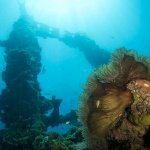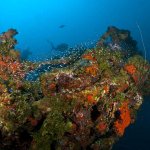Chuuk
Overview
Chuuk (Truk) Lagoon is a wreck divers paradise, suitable for both novice and experienced divers. The calm, clear, sheltered lagoon is relatively free from currents, providing safe, easy diving conditions.
The Lagoon ocean floor holds an entire Japanese fleet frozen in time, where it sank in February 1944. Complete with sake cups and skeletons, jeeps and tanks tied on board, and fighter planes still waiting in their holds, the wrecks have been declared an underwater museum. These days the battle scars, WWII ruins and underwater wrecks attract dive enthusiasts to these remote islands. As the lagoon has been declared a monument, salvage and souvenir taking of relics are prohibited by law.
From their watery grave, these ghostly skeletons give shape to a unique underwater museum. Giant ships of war rest in eerie silence among bombs, torpedoes, guns, tanks, planes, telegraphs, china, bicycles, shoes, trucks and giant 18” warheads.
Nature and time have softened and transformed this graveyard into living shipwrecks of incredible colour and marine life. Brilliant soft corals in all colours, anemones, daisy corals and sponges now cling to rusted remnants of military glory and many species of tropical fish play amongst once lethal weapons.
The majority of wrecks lie off Dublon, Eten, Fefan and Uman Islands and represent the largest naval loss in history. Nowhere else in the world are there so many wrecks in close proximity, situated in shallow, clear water. Many of the wrecks are visible to snorkellers and there are many on-shore wartime locations to visit.
Micronesia has some of the most uniform year round temperatures in the world. Temperatures range between 21º and 32ºc, with the average daily temperature for all of Micronesia around 27ºc. Humidity is around 65-75%, with the lowest rainfall in winter, from January to March. Water temperature is practically bath-like, between 27-30ºc.
Dive Sites
SS Thorfinn
A live-aboard is the ultimate way to explore the wrecks of Truk Lagoon. The SS Thorfinn is a 58 metre steam powered vessel. Accommodating 22 guests in 11 air-conditioned state rooms, this ship offers comfort, relaxation, tempting food delights, and every safety consideration, provided by a crew of 21.
Each double cabin features vanities, multi system TV/VCR’s, indirect lighting, full length closets, queen sized beds with adjacent singles, bright carpeting with modern decors, and private facilities in most quarters.
There is plenty of fresh water, spacious aft lounge and sun deck, large hot water spa, E6 film processing, complimentary windsurfer and 2 dining areas.
Two dive service areas eliminate congestion, providing each six person group with convenient valet systems of gear handling. Rinse tanks, deck showers, fresh towels and gear bins add to this facility.
The diving programme offers up to 4-5 dives per day with as many as 37 wrecks to choose from, so you could get up to 28-30 dives during 7 full days of diving. Included in your package are 3 dives per day. Extra dives can be prepaid. Dive tenders start departing from 8.00am with the last dive of the day at 8.30pm. Your experienced dive guide will maximise your diving by guiding you through the ship and pointing out the many highlights.
DIVE SITES: 37 wrecks to Dive
Some of the most popular wrecks in Truk are:
Fujikawa Maru
A 132 metre armed aircraft ferry with five holds, four of which are open. One of the most fascinating dives in Truk Lagoon. There are incomplete zero fighters in the number 2 hold, large deck guns on the bow and stern. Depth to deck is only 15 metres.
Submarine 1-169
Lying on its port side in about 38 metres of water, it is 92 metres long. During the April raid the submarine submerged to avoid damage. Unfortunately for those on board the valves were not closed during this manoeuvre and the sub sunk.
Shinkoku Maru
One of the most colourful and spectacular dives, this vessel is well preserved. Small guns are mounted fore and aft. The ship is upright in about 33 metres of water, 12 metres to the top of the bridge and 18 metres to the main deck.
Sutsuki Maru
A Destroyer, lying on it’s port side. Bow in 3 metres of water, stern with propellers at 15 metres. Gas masks and depth charges are still scattered on the deck.
Rio De Janeiro Maru
A 140 metre cargo vessel converted from a luxury passenger liner. The holds contain supplies ranging from beer bottles to guns and other military supplies. The ship is lying on its starboard side with its deck only 15 metres from the surface.
Best time to Dive
Diving is possible all year round, although the visibility varies. Best visibility is from October to May when the northeast trade winds clear the plankton-rich water. June through September is the rainy season and the calmest time of year.
Gallery
We'll find you the best value deals in the most amazing destinations. Let your active travel journey start with us!

